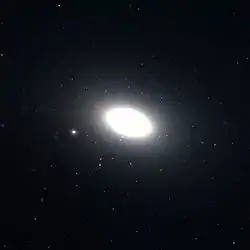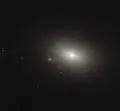NGC 3818
NGC 3818 is an elliptical galaxy in the Constellation Virgo.[5] It is at a distance of about 118 million light-years away from Earth.[2] In the center of NGC 3818 lies a supermassive black hole. NGC 3818 was discovered by William Herschel on March 5, 1785.[6][7]
| NGC 3818 | |
|---|---|
 Hubble Space Telescope image of NGC 3818 | |
| Observation data (J2000 epoch) | |
| Constellation | Virgo |
| Right ascension | 11h 41m 57.35927s[1] |
| Declination | −06° 09′ 20.4484″[1] |
| Distance | 118 ± 12 Mly (36.3 ± 3.6 Mpc)[2] |
| Characteristics | |
| Type | E5[2] |
| Apparent size (V) | 1.163′ × 0.768′[3] |
| Other designations | |
| GSC 04937-00483, LEDA 36304, UGCA 243[4] | |
Gallery
 NGC 3818 by Hubble Space Telescope.
NGC 3818 by Hubble Space Telescope.
References
- Brown, A. G. A.; et al. (Gaia collaboration) (August 2018). "Gaia Data Release 2: Summary of the contents and survey properties". Astronomy & Astrophysics. 616. A1. arXiv:1804.09365. Bibcode:2018A&A...616A...1G. doi:10.1051/0004-6361/201833051. Gaia DR2 record for this source at VizieR.
- Trinchieri, G.; et al. (May 2015). "Investigating early-type galaxy evolution with a multiwavelength approach - I. X-ray properties of 12 galaxies observed with Swift and XMM-Newton". Monthly Notices of the Royal Astronomical Society. 449 (3): 3021–3042. Bibcode:2015MNRAS.449.3021T. doi:10.1093/mnras/stv466.
- Skrutskie, M. F.; et al. (February 2006), "The Two Micron All Sky Survey (2MASS)", The Astronomical Journal, 131 (2): 1163–1183, Bibcode:2006AJ....131.1163S, doi:10.1086/498708
- "NGC 3818". SIMBAD. Centre de données astronomiques de Strasbourg. Retrieved 2021-01-11.
- "NGC 3818 - Elliptical Galaxy". theskylive.com. Retrieved 2020-09-26.
- Seligman. "Sky Atlas". Retrieved 26 September 2020.
- "NGC/IC Project Restoration Efforts". ngcicproject.observers.org. Retrieved 2020-09-26.
External links
 Media related to NGC 3818 at Wikimedia Commons
Media related to NGC 3818 at Wikimedia Commons
This article is issued from Wikipedia. The text is licensed under Creative Commons - Attribution - Sharealike. Additional terms may apply for the media files.
